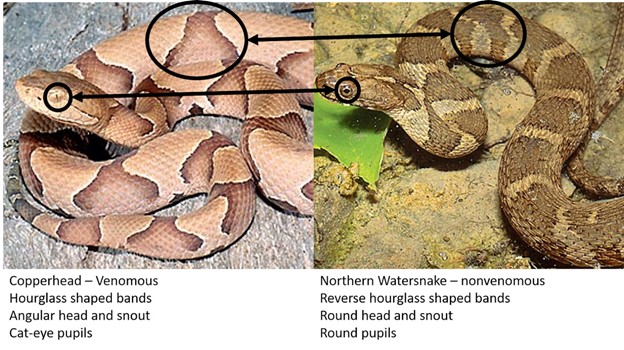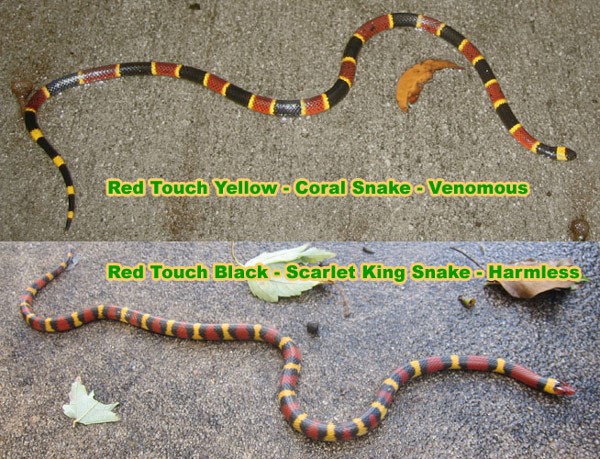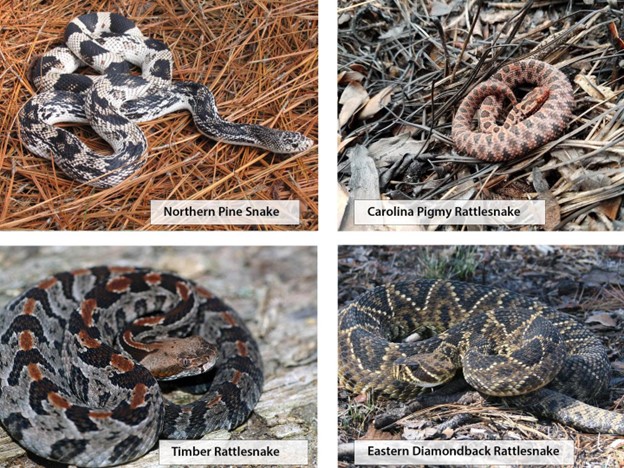Not as Venomous as They Appear
by Kristin Love
With warmer weather, outdoor enthusiasts are heading out in droves to explore waterfalls, backcountry trails, and more. But we are not the only animals coming out of our spring lull. Native wildlife, like snakes, are emerging from their underground dens to forage for food, water, and sunlight. So, it is time for a refresher on our friendly reptilian doppelgangers found here in Georgia! Armed with this knowledge, Elachee hopes to keep our community prepared to encounter wildlife and make sure that these encounters are done in a safe, positive manner with respectful distance between us as visitors and animals who call the outdoors their home.
THE WHY:
Many of Georgia’s native snakes mimic other snakes for a variety of reasons, usually done as a defensive measure through evolution. This type of mimicry, where a harmless species mimics a harmful species, is known as Batesian mimicry. Unfortunately, while this measure protects nonvenomous snakes from other predators, their lookalike nature to venomous snakes puts human beings on edge, and makes it difficult to identify them as harmless, nonvenomous species.
THE EFFECTS:
Daniel Sollenberger, Senior Wildlife Biologist for the Georgia Department of Natural Resources, says, “there are 46-48 species of snakes in Georgia depending on what scientist you talk to, but about 1/3 of those are in decline or a conservation concern”. All non-venomous snakes in Georgia are protected and it is illegal to capture, kill, or harass them on public or private land.
Sollenberger added, “you can be cited for killing a native species and then the local court system will have a lot to do with what that fine actually is, but it could be up to $1,000″.
Georgia’s Reptilian Doppelgangers
Copycat 1: Copperhead vs. Northern Water Snake

FALSE: Copperheads are extremely aggressive and hold a heavy amount of toxins in their venom that kill hundreds of people a year.
FACT: Copperheads avoid encounters with large predators (i.e., humans) at all costs. Only 5 people die per year in the entire US from ALL venomous snake bites!
Copycat 2: Scarlett King Snake vs. Coral Snake

FALSE: All venomous snakes have large, thick bodies and triangular-shaped heads.
FACT: The coral snake is slender and small, typically under 20 inches long! These snakes have a round, bulbous head, which is blunt and black, behind the eyes, and its colored bands that completely circle the body instead of breaking at the belly.
Copycat 3: Rattling

FALSE: Only Rattlesnakes can rattle, which is always aggressive behavior.
FACT: Almost all snakes can somewhat rattle their tails at an intense speed, which mimics the sound a Rattlesnake creates. Many snakes engage in this behavior to scare off potential threats, especially Corn Snakes and Pine Snakes. While Pine snakes have no federal protection, several states have them listed as threatened, with a few having laws protecting them.
The Chicopee Woods Nature Preserve provides a haven for native wildlife to be able to live their lives as naturally as possible with minimal interference from human beings. In increasing amounts, snakes’ native habitats are reallocated with higher human populations and business/residential developments, which makes natural preserves like Chicopee Woods even more vital in protecting native species in our area. We depend on the public to admire wildlife from a distance, which promotes both human and animal health and wellbeing.
If you have any questions on how to identify certain snake species or how to hike safely, please call Elachee at 770-535-1976 or email us at elachee@elachee.org.
